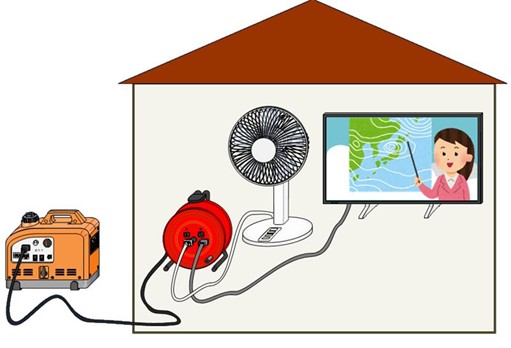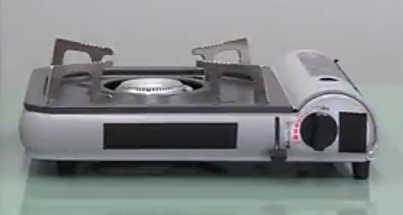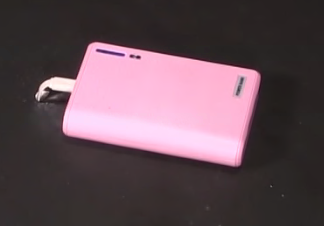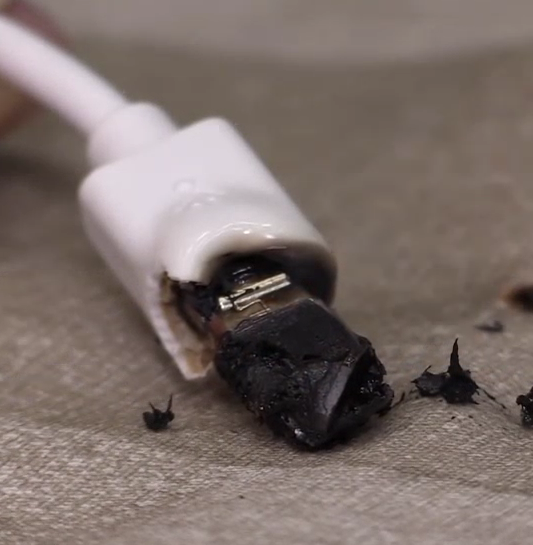- Home
- News Releases
- Back Issues
- August FY2022
- Be Careful when Using Portable Generators, Stoves, or Batteries
Be Careful when Using Portable Generators, Stoves, or Batteries
-Do not use generators indoors, as it has caused deaths-
August 26, 2022
Joint Press Release with the Consumer Affairs Agency and National Institute of Technology and Evaluation
September 1 is Disaster Preparedness Day. Portable generators, stoves, batteries, and other emergency equipment that can be useful in the event of a power outage due to disasters such as typhoons can lead to serious accidents if used incorrectly. We ask that you take the time to check how to use them correctly.
1. Portable generators
There is a growing number of households that have a portable generator as an emergency power source in case of a prolonged power outage caused by a disaster. In addition to mobile phones and televisions that serve as sources of information, it is essential to secure power for fans or electric blankets during the hot summer and cold winter months.
However, exhaust gas from portable generators contains highly toxic carbon monoxide, and there have reports of deaths due to the use of generators indoors. Please follow the precautions below and use them safely.

Figure 1: Depiction of a portable generator
[Precautions when using a portable generator]
- Never use it indoors. Exhaust gas when using a generator contain carbon monoxide that can cause poisoning if used indoors.
- Use it in a well-ventilated area, even outside.
(Related page) How to use small generators safely (in Japanese) ![]()
(Reference 1) Examples of portable generator accidents
(1) Date: September 8, 2018 (Hokkaido, a male in his fifties, died)
[Accident description]
One person died of carbon monoxide poisoning. A portable generator for household use was found at the scene.
[Accident cause]
The instruction manual stated, "Do not use in a place where exhaust gas can be trapped, as there is a risk of poisoning by exhaust gas. The exhaust gas contains harmful components such as carbon monoxide." Despite this, it is believed that the accident happened because the portable generator was used indoors during a power outage where there was insufficient ventilation, which caused the exhaust gas to accumulate and the carbon monoxide concentration to rise.
(2) Date: September 7, 2020 (Kagoshima Prefecture, one death, two serious illnesses)
[Accident description]
One person died from carbon monoxide poisoning, and two became seriously ill. A portable generator for household use was found at the scene.
[Accident cause]
No abnormalities were found in the generators and it was used indoors where there was insufficient ventilation, so it is presumed that the exhaust gas caused the carbon monoxide concentration to increase, resulting in carbon monoxide poisoning. There was a description on the main unit and in the instruction manual that stated, "There is a risk of poisoning by exhaust gas. Do not use it indoors or in a poorly ventilated area."

Figure 2: Carbon monoxide poisoning when a portable generator is used indoors (courtesy of NITE)
2. Portable stoves
There have been accidents caused by portable stoves throughout the year. In particular, there tend to be more accidents in the winter, when the temperature drops and there are more opportunities to cook hot pot dishes. However, portable stoves can also be used to cook when the gas supply is cut off due to disasters such as typhoons.
However, using a portable stove incorrectly can cause the gas cylinder to rupture, leading to a fire or other serious accident. Please follow the precautions below and use them safely.

Figure 3: Depiction of a portable stove (courtesy of NITE)
[Precautions when using a portable stove]
- Do not put two or more portable stoves next to each other or use one with a large cooking utensil on top. Heat may accumulate, and the gas cylinder may overheat and rupture.
- Insert the portable stove cylinder (gas cylinder) into the portable stove correctly. Make sure that the notch on the gas cylinder is aligned firmly with the protruding receiver. If they are not aligned, gas may leak from the gap between the gas cylinder and the stove, ignite, and start a fire.
(Reference 2) Examples of portable stove accidents
Date: December 30, 2018 (Ishikawa Prefecture, fire)
[Accident description]
A stove was ignited while a gas cylinder made by another company was inserted, causing a fire that burned the stove and its surroundings.
[Accident cause]
It is presumed that the user inserted the gas cylinder with the flange notch facing down, and the liquid gas spurted into the stove and caught fire when the user tried to ignite the stove. The label on the stove said, "Use a dedicated container (cylinder). Make sure the container (cylinder) is set correctly before using."
[Video reenactment]
3. Portable batteries
Portable batteries are essential for charging smartphones and other devices in the event of a disaster. They are very common, and some are small enough to easily carry by hand.
However, there is a certain number of accidents (fires) every year, so please follow the precautions below and use them safely.

Figure 4: Depiction of a portable battery (courtesy of NITE)
[Precautions when using a portable battery]
- In the event of a disaster, there are more chances to evacuate while carrying a portable battery or use one at an evacuation shelter. When handling portable battery, be very careful not to give it a shock. It may cause a fire.
- Make sure there is no moisture on the connector of the charging cable (Figure 5).
- When charging, use the adapter that came with the battery.

Figure 5: Depiction of a burnt charging cable connector (courtesy of NITE)
(Reference 3) Examples of portable battery accidents
Date: April 17, 2016 (Shiga Prefecture, fire)
[Accident description]
While the battery was being charged, there was a fire that burned the battery and its surroundings.
[Accident cause]
It is presumed that the battery was being charged while an AC adapter made by another company was connected to its cigar socket for output, causing the battery to heat up and ignite. The instruction manual stated, "Do not charge with anything other than the included AC100V adapter or cigar socket DC12 adapter."
Division in Charge
- Product Accident Information and Analysis Office, Product Safety Division, Industrial and Product Safety Policy Group
- Consumer Safety Division, Consumer Affairs Agency
- Product Safety and Public Relations Division, Product Safety Center, National Institute of Technology and Evaluation